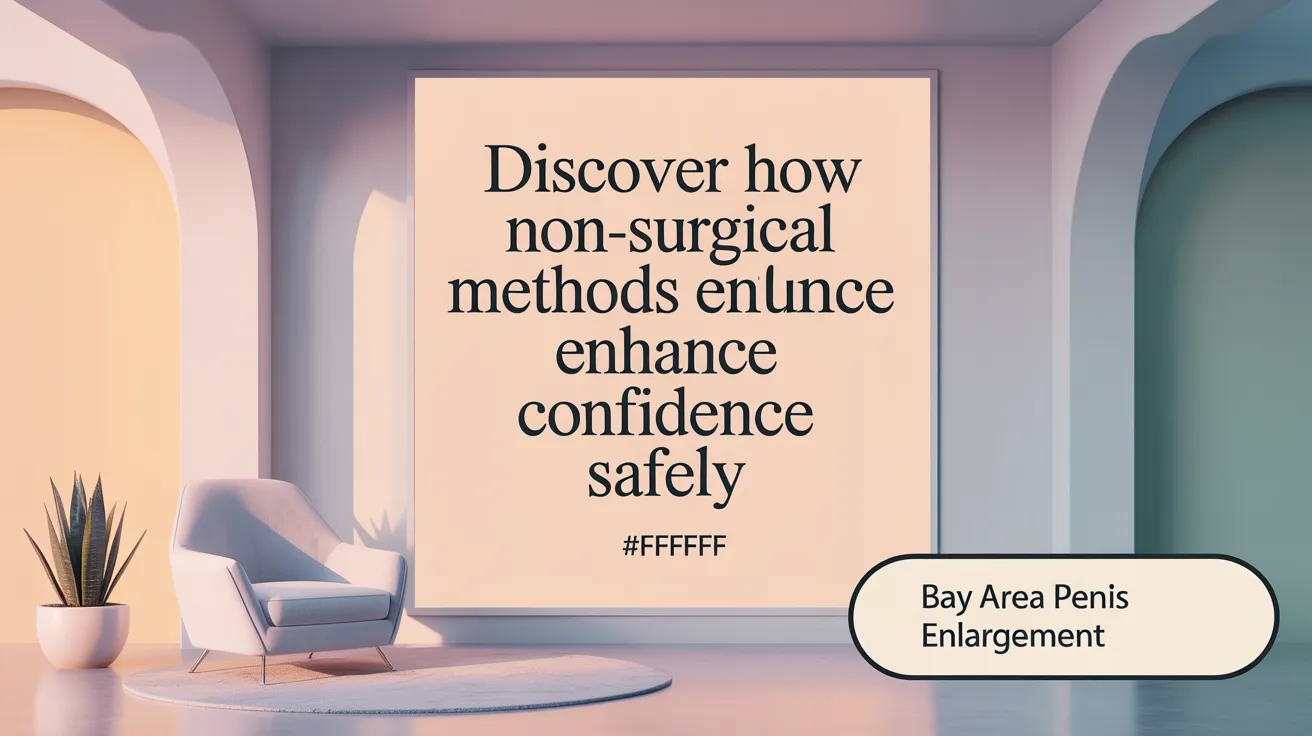Understanding True Outcomes from Penile Enhancement Procedures
Penile enhancement has long been a subject surrounded by stigma and misinformation. However, advancements in both surgical and non-surgical treatments now offer men credible options for improving penile length and girth with real, measurable results. This article explores authentic patient experiences, psychological impacts, and medical safety backed by scientific research and clinical expertise. We delve into various methods—ranging from injectable fillers and penile extenders to advanced surgeries—to present a comprehensive picture of what men can expect from these transformative procedures.
Scientific Validation of Penile Size Enhancement Techniques

What scientific evidence supports the effectiveness of penile length and girth enhancement?
Peer-reviewed research published in reputable journals such as the Journal of Sexual Medicine article provides solid evidence supporting penile size enhancement methods. Both surgical and nonsurgical treatments have demonstrated measurable improvements in penile dimensions.
Peer-reviewed evidence on penile enhancement
Scientific studies have reported significant gains in penile girth and length after treatments. For instance, injectable therapies have shown an average girth increase of around 3.29 cm (about 1.29 inches) as measured six months postprocedure. Similarly, penile-extender devices used consistently over several months can increase flaccid length by approximately 1.7 cm to 2 cm. These findings align with clinical trial results such as those reported in the Effect of Penile-Extender Device on Penile Size and nonsurgical treatment evaluations (Penile enhancement techniques and medical modalities for penile augmentation).
Clinical efficacy of length and girth improvement
Surgical methods such as ligament release combined with autologous fat transfer yield permanent length increases ranging from 2.5 to 5 cm, with girth enhancements of a similar scale. Such techniques are carefully performed by qualified specialists and have been documented to boost patient confidence with minimal impact on erectile function, as reported in clinical sources like Moorgate Andrology Penis Surgery and Cleveland Clinic Penis Enlargement Surgery.
Among surgical options, the Penuma implant is an FDA-cleared silicone device recognized as an effective solution for both penile girth and length improvement (exploring surgical penis enlargement methods).
Scientific validation of treatment methods
Studies emphasize the importance of rigorous clinical assessment in verifying the safety and efficacy of these procedures. Though some nonsurgical approaches provide temporary benefits, others like injectable fillers and tissue engineering are currently under active scientific evaluation (Penile enhancement techniques and medical modalities for penile augmentation, Penile girth enhancement controversy and fillers). While positive results are reported, the literature calls for longer-term follow-up to assess durability and potential complications (Men's psychological responses to penile girth augmentation).
In summary, current peer-reviewed research substantiates that both surgical and nonsurgical penile enhancement approaches can achieve clinically meaningful size increases. Ongoing studies aim to better define optimal techniques, safety profiles, and psychological outcomes associated with these interventions (Men's Experiences with Psychological Outcomes).
Non-Surgical Approaches: Injectable Fillers and Penile Extenders

How do non-surgical penile girth and length enhancement methods work and what results do they yield?
Non-surgical approaches to penile enhancement mainly include injectable fillers like hyaluronic acid and autologous fat grafting, alongside mechanical penile extenders.
Injectable Fillers: Hyaluronic acid gel is commonly used to increase penile girth temporarily by adding volume under the skin. Autologous fat grafting, where fat is harvested from the patient’s own body (typically from the belly or thighs) and injected, also increases girth. These methods have shown measurable results, with typical girth increases around 3 cm observed at about six months post-procedure. While effective short term, long-term safety data and durability remain limited (Penile enhancement techniques, Penile girth enhancement controversy.
Mechanical Penile Extenders: These devices stretch the penis outward by applying traction for several hours daily over months. Studies demonstrate a significant increase in flaccid penile length—up to 1.7 cm—after consistent use for around three months (Effect of Penile-Extender Device on Penile Size). Notably, penile girth changes are less predictable with extenders.
Safety and complications
Non-surgical methods are minimally invasive and tend to preserve erectile function. However, complications can occur, especially with injectables if performed outside licensed medical settings. Risks include discoloration, inflammation, granuloma formation, and in rare cases, deformities or sexual dysfunction (Penis enlargement surgery risks, Penile girth augmentation). Mechanical extenders require patient compliance and can cause discomfort or skin irritation.
In summary, injectable fillers and mechanical extenders provide viable non-surgical options with tangible increases in size and low complication rates when performed properly, but long-term effectiveness and safety require further research (Increasing penile length and girth, Men’s psychological responses to penile girth augmentation.
Surgical Innovations Delivering Permanent Penis Enlargement Results

What surgical options are currently available for permanent penile length and girth enhancement and what are their outcomes?
Several surgical techniques provide lasting improvements in penile length and girth. Ligament release surgery, also called ligamentolysis, can increase flaccid penile length by 2.5 to 5 cm. This procedure involves cutting the suspensory ligament, allowing the penis to extend further outside the body without affecting erectile function. Patients typically undergo this minor surgery on an outpatient basis and return home the same day.
For girth enhancement, fat transfer is a common technique. Surgeons harvest fat from the patient's belly or inner thighs, purify it, and inject it into the penile shaft. This results in a natural and permanent increase in penile circumference. Fat transfer avoids use of foreign implants, reducing complication risks.
Other specialized approaches include the FDA-approved Penuma implant, a silicone device wrapped around the dorsal shaft to augment girth with structural support. Corporoplastic phalloplasty with vein grafts is another surgical method that uses grafts to enhance girth.
These procedures have consistently shown permanent results with most patients experiencing greater confidence and satisfaction. Safety is prioritized by performing surgeries in accredited hospitals and ensuring urology specialists lead all interventions. Strict protocols minimize risks such as infection and erectile dysfunction.
By expertly combining these surgical innovations, men seeking permanent penile enhancement can achieve natural-looking length and girth improvements with lasting benefits.
Psychological Outcomes and Body Image Changes After Enhancement Procedures

How do penile girth and length enhancements affect men's psychological well-being and self-image?
Penile girth and length enhancements have been shown to positively influence men's psychological well-being and self-image. About half of the men receiving nonsurgical penile girth augmentation report increased self-confidence and greater sexual pleasure post-procedure. This boost in confidence reflects the significance of perceived improvements in penile size on individuals' overall self-esteem. Studies such as those published in the Journal of Sexual Medicine article on increasing penile length and girth further demonstrate the psychological benefits related to penile enhancement in healthy men.
What is the prevalence of body dysmorphic disorder among men seeking penile enhancement?
The prevalence of body dysmorphic disorder (BDD) among men seeking penile girth enhancement is relatively low, with rates between 7% and 11% depending on assessment tools used. Remarkably, follow-up studies have shown that no cases of BDD remained after treatment, highlighting that proper evaluation and treatment protocols can address underlying psychological distress effectively, as described in research on men's psychological responses to penile girth augmentation and psychological assessment in penile enhancement.
How are psychological assessments used before and after treatment?
Psychological assessments are crucial components of penile enhancement procedures. Pre-treatment evaluations help identify body image issues and conditions such as BDD to tailor treatment plans appropriately. Post-treatment assessments monitor changes in psychological distress, self-esteem, and quality of life to ensure that mental health outcomes align positively with physical enhancements. These practices are well-documented in peer-reviewed sexual health research on men's psychological outcomes and clinical studies on psychological outcomes in penile enhancement.
What improvements in self-perception and overall mental health are observed?
While men generally experience improved self-perception following penile enhancement—with reduced discrepancies between actual and ideal size—broader psychological well-being indicators such as global distress and self-esteem show mixed results. This suggests that improvements tend to be specific to body image and sexual confidence rather than comprehensive mental health changes, indicating the need for holistic psychological support alongside physical treatments. Relevant insights can be found in literature covering men's experiences and psychology in sexual behavior studies and reviews of medical modalities for penile augmentation.
Managing Risks and Complications: What Men Should Know

What Are the Risks and Complications Associated with Penile Girth and Length Enhancement Procedures?
The risks linked to penile girth and length enhancement differ depending on the chosen method. Common complications include penile fibrosis, infection, scarring, and granuloma formation. Sexual dysfunction has also been reported, along with implant-related issues such as device infection and, in rare cases, more severe outcomes. For more detailed information on Penile girth augmentation and associated complications, see this article.
Injection therapies can carry additional risks especially when unsafe or unapproved materials are used. Complications from injections may involve acute hypersensitivity reactions, migration of filler substances, and long-term deformities. The Penile soft tissue augmentation materials resource details risks of self-injection of fillers and their complications.
Why Is Psychological Screening Important Before These Procedures?
Many men seeking penile enhancement suffer from penile dysmorphophobic disorder (a subtype of body dysmorphic disorder), which complicates realistic expectations and can lead to dissatisfaction. Psychological distress often underlies the desire for enlargement, making comprehensive psychological evaluation vital to ensure patients benefit mentally and physically from treatments. Read about the Psychological impact of PDD and patient experiences.
Is Underreporting of Adverse Events a Concern?
Yes, complications from penile enhancement procedures are often underreported. This underreporting can obscure the true frequency of adverse events and hinder the establishment of safety protocols, as discussed in the Penile enhancement controversy and complications review.
Are There Guidelines and Safety Considerations for Penile Enhancement?
Reliable clinical guidelines for penile girth augmentation are largely lacking, and many procedures remain experimental. Treatments should be performed only by experienced, licensed specialists in approved clinical settings. For consensus on safety considerations, see Medical modalities for penile augmentation.
Patient selection, multidisciplinary assessment, and adherence to safety protocols are crucial to minimize risks and enhance outcomes.
| Aspect | Details | Importance |
|---|---|---|
| Common Complications | Fibrosis, infection, scarring, granulomas | High |
| Injection Therapy Risks | Hypersensitivity, filler migration | Moderate to high |
| Psychological Screening | Identification of body dysmorphia | Crucial for patient satisfaction |
| Adverse Event Reporting | Often underreported | Complicates risk assessment |
| Guidelines | Few established, mostly experimental | Recommend treatment in expert centers |
For additional surgical option details consult resources about the Penuma implant, Penuma implant, Penuma implant, Penuma implant, and Penuma implant.
Patient Experiences: Real Stories Behind the Numbers
What do actual patients report about their penile enhancement outcomes?
Many men who undergo penile enhancement procedures report notable improvements in both length and girth. Clinical data and patient testimonials often cite length increases ranging from 2.5 to 5 cm, with similar gains in girth achieved through methods such as surgical ligament release and autologous fat transfer. These physical changes align closely with the results documented in trusted medical practices like those described at Moorgate Andrology and documented in medical study on penile size.
Beyond measurable improvements, patients frequently describe heightened self-confidence and greater sexual satisfaction. Enhanced body image and improved sexual experiences are commonly mentioned benefits, contributing to better overall quality of life, as supported by research on men's psychological responses to penile girth augmentation and broader men's psychological experiences.
How important is personalized treatment?
Personalized treatment is essential for successful outcomes. Medical professionals emphasize tailoring approaches based on individual anatomy, psychological health, and personal enhancement goals. Psychological assessment before and after procedures helps ensure realistic expectations and addresses any underlying distress, such as body dysmorphic concerns, as highlighted in studies on psychological factors in penile enhancement and issues like penile dysmorphophobic disorder (PDD). Experts such as Dr. Alex Shteynshlyuger also emphasize personalized treatment planning to optimize results and safety.
What are the trends in clinical practice testimonials?
Clinics specializing in penile enhancement, like Moorgate Andrology and others, report positive patient feedback highlighting natural results and satisfaction with the safety and effectiveness of procedures. Testimonials often underscore the role of comprehensive care, including pre-operative counseling and post-operative support, contributing to favorable experiences.
This strong alignment between clinical evidence and patient-reported outcomes demonstrates that individualized, medically supervised penile enhancement can lead to both physical and psychological benefits for many men. Detailed clinical evidence includes findings on surgical and nonsurgical methods, documented in peer-reviewed journal on sexual medicine and comprehensive reviews of penile enhancement techniques and patient satisfaction. The innovative Penuma implant remains a key surgical option showing promising outcomes for girth and length enhancement.
Future Directions and Integration of Psychological and Medical Care
What is the future outlook for penile girth and length enhancement combining medical innovation with psychological care?
The future of penile girth and length enhancement is moving towards an integration of advanced medical techniques and comprehensive psychological care. Emerging innovations like tissue engineering, biodegradable scaffolds, and improved implant technologies such as the Penuma implant offer potential for safer and more effective augmentation with natural results.
Minimally invasive surgical advancements reduce recovery times and complications, while techniques like fat grafting and injectable fillers continue to evolve with better safety profiles. However, the psychological component plays a crucial role, as many men seeking enhancement suffer from body image disorders including penile dysmorphophobic disorder (PDD) or body dysmorphic disorder (BDD) (Penile girth augmentation.
Multidisciplinary care teams are increasingly emphasizing mental health assessments alongside physical treatments. This holistic approach helps identify and address underlying psychological distress, improving patient satisfaction and outcomes by setting realistic expectations and offering counseling support (Men's Experiences with Psychological Outcomes.
Ongoing research is essential to establish rigorous clinical guidelines that define the safety, efficacy, and standardized protocols for both surgical and nonsurgical modalities. Current procedures are often experimental with varied complication rates, underscoring the need for long-term data (Penile enhancement techniques.
As clinical guidelines evolve, combining psychological evaluation with medical innovation ensures a balanced, patient-centered approach. This integration aims to optimize not only the physical improvements in penile size but also enhance psychological well-being and quality of life for patients (Increasing penile length and girth).
Authentic Transformations Backed by Science and Compassion
Penile girth and length enhancement procedures have evolved from controversial territory to medically credible options supported by rigorous scientific research and clinical expertise. Both non-surgical and surgical methods show real, lasting results with improvements not only in penile size but also in men's self-confidence and sexual satisfaction. Importantly, the integration of psychological assessment ensures that men's mental health is safeguarded throughout the process. With ongoing innovation and a commitment to safety, these enhancements continue to transform lives, empowering men to feel more comfortable and fulfilled in their bodies.

